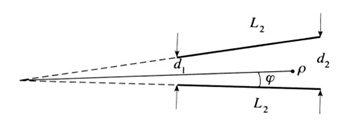
Not-so-parallel Plate Capacitor
 المؤلف:
Sidney B. Cahn Boris E. Nadgorny
المؤلف:
Sidney B. Cahn Boris E. Nadgorny
 المصدر:
A GUIDE TO PHYSICS PROBLEMS
المصدر:
A GUIDE TO PHYSICS PROBLEMS
 الجزء والصفحة:
part 1 , p 51
الجزء والصفحة:
part 1 , p 51
 11-8-2016
11-8-2016
 1677
1677
Not-so-parallel Plate Capacitor
a) A capacitor is formed by two rectangular conducting plates having edges L1 and L2. The plates are not parallel. One pair of edges of length L1 is separated by a distance d1 everywhere, and the other pair of edges of length L1 is separated by d2 everywhere; d2 > d1

Figure 1.1
(see Figure 1.1). Neglecting edge effects, when a voltage difference V is placed across the two conductors, find the potential everywhere between the plates.
b) Determine the capacitance.
SOLUTION
a) Consider this problem in cylindrical coordinates, so that the plates are along the radii (see Figure 1.2). The Laplace equation,  then
then


Figure 1.2
becomes

 (1)
(1)
Writing ϕ = R(ρ)χ (φ), we may separate (1) into two differential equations


where R is the radial part of the potential, χ is the azimuthal part, and n is some constant. In the small-angle approximation (which can be assumed since we are allowed to disregard the edge effects), we can say that R is independent of ρ, and then


for which we have the solution χ = Aφ + B. From the boundary condition χ(0) = 0, we have B = 0, and using the other condition χ(φ0) = V, we find that


where

 (4)
(4)
b) Using the result of (a) and the expressions for the of the field energy U contained in a capacitor, we may find the capacitance. We have

 (5)
(5)
Here,


so (5) becomes


Hence, the capacitance

 (6)
(6)
In the limit of d2 → d1 = d (the case of a parallel plate capacitor), (6) reduces to


 الاكثر قراءة في مواضيع اخرى
الاكثر قراءة في مواضيع اخرى
 اخر الاخبار
اخر الاخبار
اخبار العتبة العباسية المقدسة


